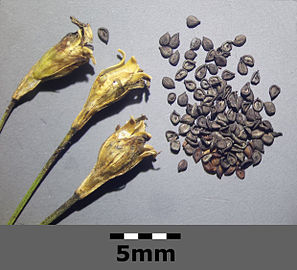Petrorhagia saxifraga
| Petrorhagia saxifraga | |
|---|---|

| |
| Scientific classification | |
| Kingdom: | Plantae |
| Clade: | Tracheophytes |
| Clade: | Angiosperms |
| Clade: | Eudicots |
| Order: | Caryophyllales |
| Family: | Caryophyllaceae |
| Genus: | Petrorhagia |
| Species: | P. saxifraga
|
| Binomial name | |
| Petrorhagia saxifraga | |
| Synonyms[1] | |
|
List
| |
Petrorhagia saxifraga, known as tunic flower or coat flower, is a small, herbaceous flowering plant in the family Caryophyllaceae.[1][2] It is native to parts of Europe and introduced to the United States and Canada, Great Britain, and Sweden.[1][2] Petrorhagia saxifraga is also known as tunic saxifrage, pink saxifrage, or just pink.[3][4]
It is a wiry plant with numerous branching stems, narrow leaves, and flowers growing solitary at the ends of branches. The petals range from pink to white.[5] It is commonly cultivated in rock gardens and used along borders, escaping to grow in lawns, along roadsides, along shorelines, and in other sandy disturbed areas.[2][4][6]
Tunic flower was originally described as Dianthus saxifragus by Carl Linnaeus in 1753 and renamed Petrorhagia saxifraga in 1831.[7][8] The genus and species name refer to its natural habitat: rock crevices.[3] Two subspecies are accepted:
- Petrorhagia saxifraga subsp. gasparrinii (Guss.) Pignatti ex Greuter & Burdet
- Petrorhagia saxifraga subsp. saxifraga (L.) Link
References
[edit]- ^ a b c d "Petrorhagia saxifraga (L.) Link". Plants of the World Online. Royal Botanical Gardens Kew. Retrieved 6 January 2018.
- ^ a b c Rabeler, Richard K.; Ronald L. Hartman (2005). "Petrorhagia saxifraga". In Flora of North America Editorial Committee (ed.). Flora of North America North of Mexico (FNA). Vol. 5. New York and Oxford: Oxford University Press. Retrieved 6 January 2019 – via eFloras.org, Missouri Botanical Garden, St. Louis, MO & Harvard University Herbaria, Cambridge, MA.
- ^ a b "Petrorhagia saxifraga - Plant Finder". www.missouribotanicalgarden.org. Missouri Botanical Garden. Retrieved 6 January 2019.
- ^ a b Reznicek, A. A.; Voss, E. G.; Walters, B. S., eds. (February 2011). "Petrorhagia saxifraga". Michigan Flora Online. University of Michigan Herbarium. Retrieved 6 January 2019.
- ^ Wilhelm, Gerould; Rericha, Laura (2017). Flora of the Chicago Region: A Floristic and Ecological Synthesis. Indiana Academy of Sciences.
- ^ Rabeler, Richard K.; Ronald L. Hartman (2005). "Petrorhagia saxifraga (Linnaeus) Link var. saxifraga". In Flora of North America Editorial Committee (ed.). Flora of North America North of Mexico (FNA). Vol. 5. New York and Oxford: Oxford University Press. Retrieved 6 January 2019 – via eFloras.org, Missouri Botanical Garden, St. Louis, MO & Harvard University Herbaria, Cambridge, MA.
- ^ "Petrorhagia saxifraga (L.) Link". ipni.org. International Plant Names Index. Retrieved 6 January 2018.
- ^ "Dianthus saxifragus L." ipni.org. International Plant Names Index. Retrieved 6 January 2018.



